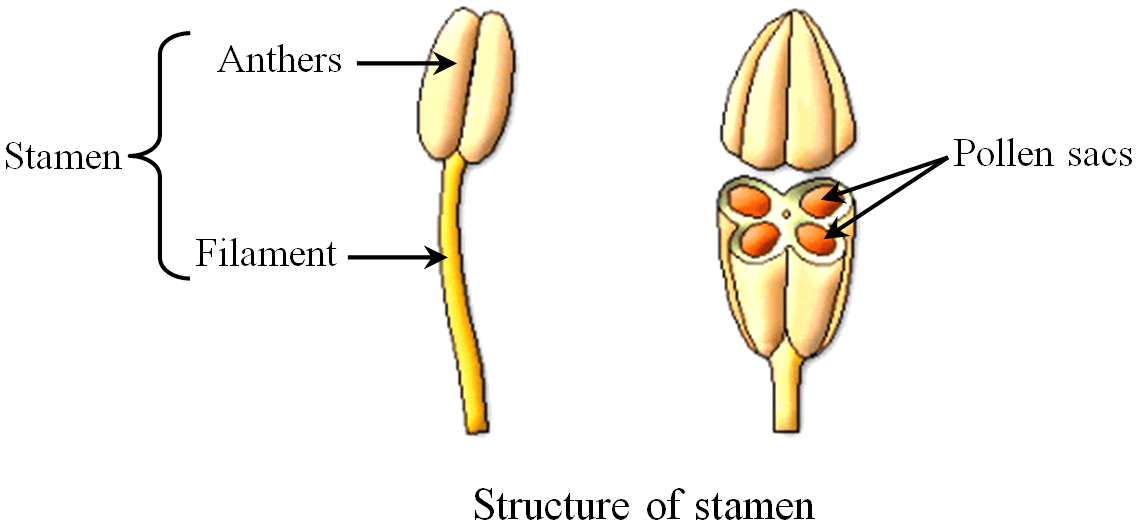
Name the male part of the flower. Write names of its parts and draw a diagram.
Answer
494.4k+ views
Hint: The male part of the flower is constituted with the whorl called androecium.
Complete Answer:
Flowers are the fascinating plant organs. For us they hold serene and aesthetic values. For cultivators they are the providers of seeds. That is because flowers are the organs of sexual reproduction in flowering plants or the angiosperms.
Now, if we are referring to flowers as the sexual organs, they must have male and female reproductive organs. Well, yes, a perfect flower has the following parts:
1. Sepals, arranged in a whorl called calyx.
2. Petals, arranged in whorls called corolla.
3. Male reproductive parts or stamens, arranged in a whorl called androecium.
4. Female reproductive parts or pistil, arranged in a whorl called gynoecium.
Talking about the male reproductive part of stamen, it has the following parts:
1. Anther: It is a bilobed and tetrasporangiate structure in which the sporogenous tissue is present. The cells of the sporogenous tissue give rise to the microspore or pollen mother cells which produce pollen grains through meiosis. The pollen grains are the haploid amle gametophyte that carries the male gametes.
2. Filament: It is a stalk-like structure that connects anther to the thalamus of the flower and acts as the conduit for the nutrition to anther.
3. Connective: It is a tissue that connects two lobes of the bilobed anther.

Note: The anther is surrounded by layers from outside to inside as follows:
Epidermis, Endothecium, that helps in anther dehiscence, Middle layers, Tapetum, that provides nourishment to the developing pollen grains.
Complete Answer:
Flowers are the fascinating plant organs. For us they hold serene and aesthetic values. For cultivators they are the providers of seeds. That is because flowers are the organs of sexual reproduction in flowering plants or the angiosperms.
Now, if we are referring to flowers as the sexual organs, they must have male and female reproductive organs. Well, yes, a perfect flower has the following parts:
1. Sepals, arranged in a whorl called calyx.
2. Petals, arranged in whorls called corolla.
3. Male reproductive parts or stamens, arranged in a whorl called androecium.
4. Female reproductive parts or pistil, arranged in a whorl called gynoecium.
Talking about the male reproductive part of stamen, it has the following parts:
1. Anther: It is a bilobed and tetrasporangiate structure in which the sporogenous tissue is present. The cells of the sporogenous tissue give rise to the microspore or pollen mother cells which produce pollen grains through meiosis. The pollen grains are the haploid amle gametophyte that carries the male gametes.
2. Filament: It is a stalk-like structure that connects anther to the thalamus of the flower and acts as the conduit for the nutrition to anther.
3. Connective: It is a tissue that connects two lobes of the bilobed anther.

Note: The anther is surrounded by layers from outside to inside as follows:
Epidermis, Endothecium, that helps in anther dehiscence, Middle layers, Tapetum, that provides nourishment to the developing pollen grains.
Recently Updated Pages
Master Class 12 Economics: Engaging Questions & Answers for Success

Master Class 12 Maths: Engaging Questions & Answers for Success

Master Class 12 Biology: Engaging Questions & Answers for Success

Master Class 12 Physics: Engaging Questions & Answers for Success

Master Class 12 Business Studies: Engaging Questions & Answers for Success

Master Class 12 English: Engaging Questions & Answers for Success

Trending doubts
The probability that a leap year will have only 52 class 12 maths CBSE

Draw a labelled sketch of the human eye class 12 physics CBSE

The final image formed by a compound microscope is class 12 physics CBSE

Differentiate between homogeneous and heterogeneous class 12 chemistry CBSE

What are the major means of transport Explain each class 12 social science CBSE

Which of the following properties of a proton can change class 12 physics CBSE




